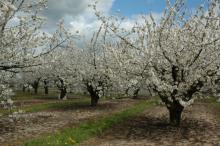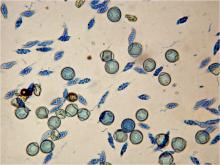Do fungicides inhibit pollen? Yes, but mostly in the laboratory. Fungicides do not inhibit fruit set and yield.
Several fungicides inhibit pollen germination. This has been documented in several trials on many plants with many different fungicides. Plant pollen investigated includes apple, blueberry, cherry, cranberry, pecan, raspberry, and strawberry. Benomyl, captan, dinocap, mancozeb, sulfur, triforine, and zineb inhibited germination of apple pollen. However, fungicide effects varied by apple cultivar. Triforine inhibited blueberry pollen. Benomyl, dodine, propiconazole, sulfur, and thiophanate-methyl inhibited pecan pollen. Captan and ferbam reduced cherry pollen germination, but sulfur did not. (Note - many of these fungicides are no longer registered either for the crops mentioned or at all.)
Most of this research was done in the test tube (in vitro). Generally, the fungicide in question is incorporated into an agar growth medium; then pollen is placed on it and allowed to germinate for a standard length of time. Sometimes, pollen is treated before dehiscence from the anther, then placed on an agar medium without any fungicides. Effects of fungicides range from poor germination to shortened germ tube length or impaired pollen release from the anthers.
Many of these effects are observed only within a short time after flowers are treated in the field. Apple pollen recovered to normal levels within 24 to 48 hours of a fungicide application. Blueberry was most sensitive to triforine within 2 hours of application. In each case, however, no significant reductions in fruit set and development have been reported even when the most inhibitory fungicides were used at full bloom. There was also no effect of fungicide application on bee foraging behavior.
Although the research papers are generally very cautious, one can conclude that fungicides applied during bloom do not pose a significant risk to fruit production in the crop systems studied. The only exception reported is a reduction in cranberry fruit size.
References
Bristow, P.R. 1981. Effect of triforine on pollen germination and fruit set in highbush blueberry. Plant Disease 65:350-353.
Church, R.M. and Williams, R.R. 1977. The toxicity to apple pollen of several fungicides, as demonstrated by in vivo and in vitro techniques. Journal of Horticultural Science 52:429-436.
Church, R.M. and Williams, R.R. 1978. Fungicide toxicity to apple pollen in the anther. Journal of Horticultural Science 53:91-94.
Eaton, G.W. 1961. Germination of sweet cherry (Prunus avium L.) pollen in vitro as influenced by fungicides. Canadian Journal of Plant Science 41:740-743.
Fell, R.D., Rajotte, E.G., and Yoder, K.S. 1983. Effects of fungicide sprays during apple bloom on pollen viability and honey bee foraging. Environmental Entomology 12:1572-1575.
He, Y. and Wetzstein, H.W. 1994. Pollen degeneration and retarded leaf development from fungicidal sprays applied during microspore development and shoot expansion. Journal of Horticultural Science 69:975-983.
He, Y., Wetzstein, H.Y., and Palevitz, B.A. 1995. The effects of a triazole fungicide, propiconazole, on pollen germination, tube growth and cytoskeletal distribution in Tradescantia virginiana. Sexual Plant Reproduction. 8:210-216.



